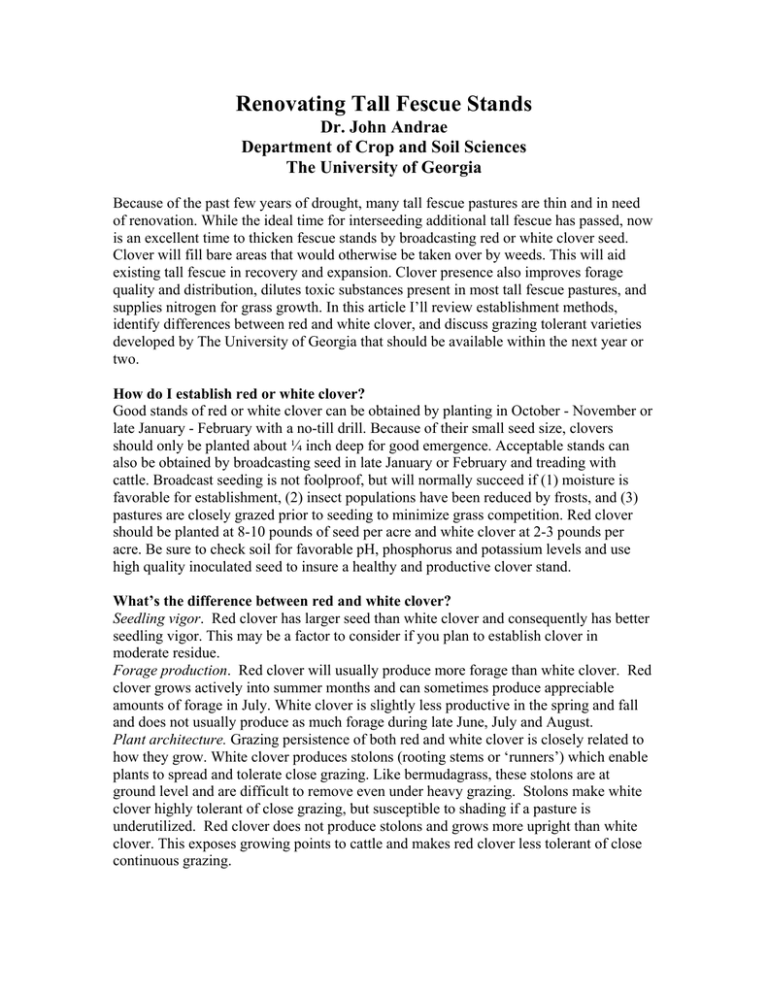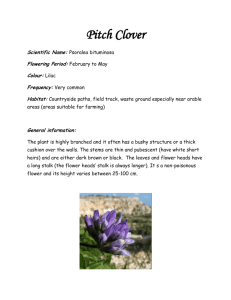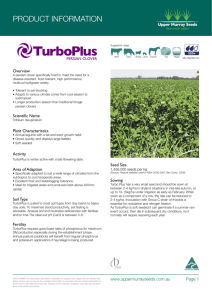Renovating Tall Fescue Stands Dr. John Andrae The University of Georgia
advertisement

Renovating Tall Fescue Stands Dr. John Andrae Department of Crop and Soil Sciences The University of Georgia Because of the past few years of drought, many tall fescue pastures are thin and in need of renovation. While the ideal time for interseeding additional tall fescue has passed, now is an excellent time to thicken fescue stands by broadcasting red or white clover seed. Clover will fill bare areas that would otherwise be taken over by weeds. This will aid existing tall fescue in recovery and expansion. Clover presence also improves forage quality and distribution, dilutes toxic substances present in most tall fescue pastures, and supplies nitrogen for grass growth. In this article I’ll review establishment methods, identify differences between red and white clover, and discuss grazing tolerant varieties developed by The University of Georgia that should be available within the next year or two. How do I establish red or white clover? Good stands of red or white clover can be obtained by planting in October - November or late January - February with a no-till drill. Because of their small seed size, clovers should only be planted about ¼ inch deep for good emergence. Acceptable stands can also be obtained by broadcasting seed in late January or February and treading with cattle. Broadcast seeding is not foolproof, but will normally succeed if (1) moisture is favorable for establishment, (2) insect populations have been reduced by frosts, and (3) pastures are closely grazed prior to seeding to minimize grass competition. Red clover should be planted at 8-10 pounds of seed per acre and white clover at 2-3 pounds per acre. Be sure to check soil for favorable pH, phosphorus and potassium levels and use high quality inoculated seed to insure a healthy and productive clover stand. What’s the difference between red and white clover? Seedling vigor. Red clover has larger seed than white clover and consequently has better seedling vigor. This may be a factor to consider if you plan to establish clover in moderate residue. Forage production. Red clover will usually produce more forage than white clover. Red clover grows actively into summer months and can sometimes produce appreciable amounts of forage in July. White clover is slightly less productive in the spring and fall and does not usually produce as much forage during late June, July and August. Plant architecture. Grazing persistence of both red and white clover is closely related to how they grow. White clover produces stolons (rooting stems or ‘runners’) which enable plants to spread and tolerate close grazing. Like bermudagrass, these stolons are at ground level and are difficult to remove even under heavy grazing. Stolons make white clover highly tolerant of close grazing, but susceptible to shading if a pasture is underutilized. Red clover does not produce stolons and grows more upright than white clover. This exposes growing points to cattle and makes red clover less tolerant of close continuous grazing. Stand persistence. Currently, both red and white clover stands are short lived in most areas of Georgia. Red clover will usually remain productive in a pasture for one year after establishment. Two years of production can occasionally be obtained with proper grazing management and low disease pressure. Cherokee is the recommended variety for South Georgia. Cinnamon, Redland III, RedlanGraze, Royal Red, and Rudolph are good varieties for North Georgia. Ladino varieties of white clover (i.e. Will, Regal, Osceola) are generally productive for two years and will occasionally last for three years depending on weather, soil fertility, grazing management and disease pressure. Can clover persistence be improved? Because these clovers only persist for a few years, many producers are reluctant to establish them in pastures. Development of grazing-tolerant red clovers has been difficult, but there has been good progress in selecting white clover persistence in grazed grass sod. Dr. Joe Bouton at The University of Georgia selected clover from pastures where none had been seeded for many years. These selections were planted in tall fescue plots and subjected to heavy grazing in a harsh environment. Persistent plants were selected, bred, and evaluated to ultimately develop a productive white clover that is tolerant of grazing in tall fescue sods. Currently there are two experimental white clover varieties with exceptional grazing tolerance. One variety is currently assigned the identification number of GA43 (Commercial name is now Durana). This variety has intermediate leaves and grows close to ground level, similar to white dutch clover. It has several features which should improve persistence in pastures. First, Durana produces many more stolons or ‘runners’ than available ladino clovers. These stolons produce abundant leaves that grow close to ground level. As mentioned previously, stolons allow clover to spread and improve grazing tolerance. Second, Durana produces a large amount of flowers and blooms for a longer period of time than available ladino varieties. This should increase seed production and make this variety a more dependable reseeder. To emphasize the importance of stolon production, I’ve included data from a small-plot grazing trial Dr. Carl Hoveland conducted at the Northwest Branch Experiment Station near Calhoun. Osceola ladino clover, Durana white clover, and five red clovers were planted into bermudagrass sod in October 1997 and continuously grazed in drought conditions from April to late October for two years. After the first year of grazing, clover density had decreased in both Osceola white clover and the five red clover varieties tested; however, Durana plant density remained high (Table 1). After two years of heavy grazing, Durana had 48 growing points per square foot, Osceola had 5 growing points per square foot and the five red clover varieties were no longer present in the field. One characteristic of Durana is that it produces less forage during the establishment year than available ladino clovers. To improve yields, the Durana variety was crossed with a ladino variety to produce a clover with plant characteristics intermediate to ladino clover and Durana. This cross is currently known as GA 21159 (Commercial name now Patriot) and produces establishment year yields that approach ladino clovers. Patriot also persists well under heavy grazing and has good disease tolerance. It is important to note that although establishment year yields of both Durana and Patriot are lower than ladino clovers, two year average yields are equal because ladino clover stands have begun to thin. Focusing only on yields in grazing situations can be misleading. First, forage yields give no indication of long-term plant persistence. Second, a major benefit of including clover in pastures is the dilution of toxins present in tall fescue. Grazing trials currently underway show that both Durana and Patriot effectively dilute tall fescue toxins and improve animal gains. There are no commercial names currently assigned to these new clover varieties, but seed should be available in limited quantities in fall 2003. Several on-farm demonstration plots have been seeded throughout the state to test in-field performance. I’ll relay commercial seed names and distributors for those interested in establishing these new varieties as soon as they become available. Some of best white clover varieties presently on the market are Osceola, Regal and Will. Osceola was developed in Florida and is less cold hardy than Regal and Will. It should probably not be planted in the Upper Piedmont and Mountain areas of the state but will perform well in the lower Piedmont and Coastal Plain. These varieties are a great option for helping renovate thinned tall fescue pastures. Table 1. Survival of clovers interseeded in bermudagrass after one year of grazing. Northwest Branch Experiment Station, Calhoun Clover type Durana Osceola Average of 5 red clovers Plants per square foot May 1998 December 1998 5 6 6 2 9 1 Growing points per square foot December 1999 48 5 0




